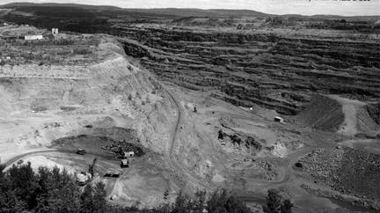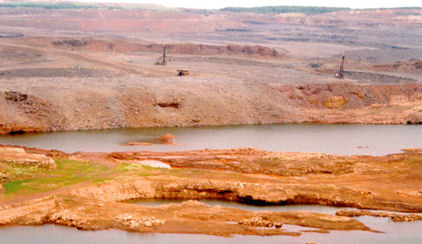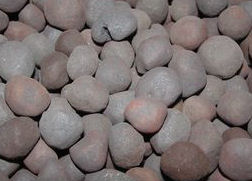Mesabi Iron Range

Mesabi Area and Mining:
- Largest of regional iron ranges
- Discovered in 1866 by the Merritt Brothers and others soon made discoveries in surrounding areas
- Originally, there were underground mines in the area. It was soon discovered that there were ore deposits close to the surface, thus the development of Open Pit Mining.
- The Merritt Brothers did not have the funds to build a railroad to Lake Superior to ship the ore, and subsequently their ownership of the Mesabi area went to John D. Rockefeller. Rockefeller in turn sold it to Andrew Carnegie who transferred it to U.S. Steel Corporation when many of the smaller open pit mines in the area merged into one mine.
- The town of Hibbing was relocated in 1919 as a result of expansion of the Mesabi Iron Range.
- The mined ore is transported by railroad to ports on the Great Lakes, primarily Two Harbors and Duluth, where it is placed on ships and sent to iron mills in Indiana and Ohio. The trains can have up to eighty 100 ton open cars of ore and the ships can hold up to 60,000 tons. A You Tube and a Slide Show depicting these aspects can be found here: Central_Mining_General Information
Open Pit Mining:
 Open Pit mine at Virginia, Minnesota
Open Pit mine at Virginia, Minnesota
- Open pit mining is a way of extracting rock and minerals from a large pit or borrow when the product is close to the surface.
- The Hull-Rust-Mahoning Mine in Hibbing is the largest open pit mine in the world. It is more than three miles long, two miles wide, and 535 feet deep
Hull - Rust - Mahonning Mine 
- More than 2.5 billion ton of ore have been mined from the Mesabi Iron Range
- By the mid 1960s the original hematite ore (a high grade of ore) supply was depleted. At that time, the taconite (a lesser grade of ore) which had been cast aside during the extraction of the hematite ore became valuable.
Taconite Mining:
- The taconite ore is found within a tough variety of quartz (chert). The rock is blasted and the magnetic taconite iron particles are separated from the chert.
- The separated taconite ore is ground to a powder form, combined with water, Bentonite clay, limestone, and dolomite (to help hold it together), and rolled into pellets about the size of marbles. The pellets are baked and become hard so they can withstand the shipping process. The taconite pellets contain up to 65% pure iron and are magnetic.
Taconite Pellets 
Mesabi Iron Range Today:
- Mining operations declined during the mid 1970s but rebounded in 2005
- Some closed mines reopened, while others expanded their operations
- The Mesabi Range currently produces 75% of all the domestic ore.
Return to: Central_Mining
Photos courtesy of:
Comments (0)
You don't have permission to comment on this page.